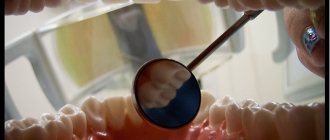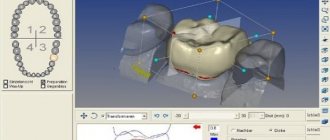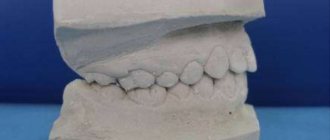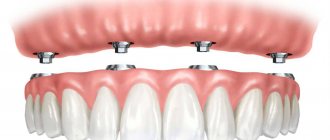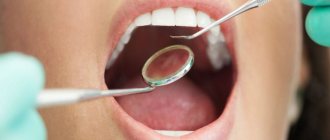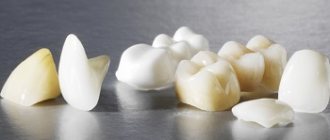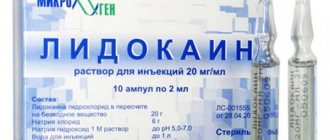Dentures are an ideal solution for people who have lost teeth. There is an alternative method - dental implantation, but dental prosthetics has significantly fewer contraindications, although it is not absolutely safe.
Very unpleasant complications occur, one of which is an allergy to dentures.
An allergic reaction can occur due to the body's failure to accept foreign material. Often people are unaware of such a reaction, so when they encounter a problem for the first time, they cannot understand what is happening and how to deal with it.
The first thing you need to remember is that if certain discomfort and unpleasant symptoms appear, you should consult a doctor. If it is not possible to quickly get help from a specialist, then you can minimize the risk of further inflammation by removing the source of irritation from the oral cavity.
What causes allergies
An allergy to a dental crown, like any allergy in principle, is a pathological reaction of our immunity, which is expressed in increased sensitivity (hypersensitivity) to some allergen substance. It is interesting here that sensitization or stage 1 occurs first - when the body first encounters an “unfriendly” substance in very small quantities. At this stage, the components of the immune system - B lymphocytes, T helper cells, mast cells, endothelial cells, dendritic cells - react weakly. That is, there are no tangible manifestations1 of an allergic reaction yet.
At stage 2, when the body encounters a large amount of allergen, the allergic reaction itself occurs, with all its manifestations and symptoms (more on them below). Moreover, from the 1st to the 2nd stage, very little time can pass - literally a few minutes or hours. Especially if the allergen is strong enough - in principle or specifically for you as an individual.
Only until 30.09 South Korean implant Osstem - 19,900 rubles.
Hurry up to sign up for a free consultation and lock in promotional prices.
Call now or request a call
Opening hours: 24 hours a day - seven days a week
Contraindications to professional cleaning
Like any health procedure, professional oral care has its contraindications. You should not agree to brush your teeth if you have the following diseases:
- mucosal injuries;
- hepatitis B and C, HIV, AIDS;
- poor blood clotting;
- pathologies of the respiratory system;
- allergy to fluoride-containing drugs;
- any serious diseases of internal organs;
- diseases of teeth and gums in the acute phase.
Symptoms of an allergic reaction
Allergies can appear either immediately after prosthetics or over a longer period of time - after several days, weeks or months, or less often after several years. Therefore, you need to know what symptoms are signs of an allergic reaction. How an allergy to crowns manifests itself (and there can be either one symptom or several at once), we will describe further:
- problems with the gums and mucous membranes: redness, itching, pain, swelling, rash, sores, blisters with fluid inside - all this may indicate allergic stomatitis,
- unpleasant sensations on the tongue and palate: numbness, tingling, burning, goosebumps, metallic or sour taste,
- disruptions in the production of saliva: too much or too little of it is formed, dry mouth appears,
- nasal congestion, runny nose, sneezing,
- pain and sore throat, dry cough, pain when swallowing,
- the appearance of rashes or red spots on the skin (on the face, neck, chest, arms),
- tearfulness, redness of the eyes,
- exacerbation of existing body diseases: asthma, gastrointestinal pathologies, etc.,
- temperature increase,
- enlarged lymph nodes,
- Quincke's edema: a very dangerous condition in which some part of the body or face or neck becomes severely swollen. The danger is that due to swelling of the neck and throat, it becomes difficult to breathe (you can even suffocate). Blood vessels that supply oxygen to the brain may also be pinched.
Is professional cleaning harmful?
Competent professional oral care is absolutely safe for the health of teeth and gums, provided that the patient has no contraindications for it. You should not clean more than twice a year; more frequent professional care can lead to thinning of the enamel. Microcracks will appear on the teeth, which can cause caries. Frequent cleanings (3-4 times a year) are justified in case of increased saliva viscosity or mineral metabolism disorders.
Another feature of abrasive brushing is the inevitable trauma to the gums. In the presence of dental plaque, the tissues become inflamed to one degree or another and, when exposed to a jet of powder, begin to bleed.
To avoid discomfort after professional teeth cleaning, use Asepta ACTIVE mouth rinse to speed up gum healing. This unique two-component product with a combination of chlorhexidine + benzidamine has an antimicrobial, anti-inflammatory and analgesic effect, providing an instant anesthetic effect to even the most sensitive gums.
- gel for gums
- gel for gums for inflammation
- gel for teeth and gums
- gum treatment gel
- gum strengthening gel
- best gel for gums
What materials provoke allergies?
The following substances can provoke an allergic reaction in orthopedic dentistry:
- synthetic polymers: plastic, nylon, acrylic, etc.,
- metals: base metals are more likely to become allergens than noble metals,
- anesthetic drugs, filling compounds, antiseptics: if used incorrectly, they can cause local irritation,
- dental cement on which dentures are glued.
But ceramics, zirconium and aluminum dioxides, composite materials for filling, as well as titanium without impurities are considered hypoallergenic.
Don't know what type of prosthetics to choose?
We will help in the selection, advise where to read more information and compare types of prosthetics.
Consultation with an orthopedic doctor in Moscow clinics is free! Call now or request a call
Working hours: from 9:00 to 21:00 - seven days a week
However, there is still no material for prosthetics that is 100% inert, i.e. There is always a risk of allergies - to a large extent it depends on the person himself, his individual reaction. At the same time, modern high-quality materials are very well cleaned at the production stage, and the maximum amount of harmful substances is removed from them. Therefore, they can cause problems extremely rarely - in 1 case out of a million or even less often.
Clinical researches
Asept toothpastes and rinses are clinically proven effective. For example:
- Repeated clinical studies have proven that using ASEPTA propolis gum gel for a week can reduce gum inflammation by 31%.
- It has been clinically proven that regular use of professional toothpaste ASEPTA REMINERALIZATION after 4 weeks improved the condition of the enamel by 64% and reduced tooth sensitivity by 66%.
- Repeated clinical studies have proven that the two-component mouth rinse ASEPTA ACTIVE more effectively combats the causes of inflammation and bleeding compared to single-component rinses - it reduces inflammation by 41% and reduces bleeding gums by 43%.
Sources:
- The effectiveness of the use of Asept “adhesive balm” and Asept “gel with propolis” in the treatment of chronic generalized periodontitis and gingivitis in the acute stage (Municipal Dental Clinic No. 4, Bryansk, Kaminskaya T. M. Head of the therapeutic department Kaminskaya Tatyana Mikhailovna MUZ City Dental Clinic No. 4, Bryansk
- Report on the determination/confirmation of the preventive properties of personal oral hygiene products “ASEPTA PLUS” Remineralization doctor-researcher A.A. Leontyev, head Department of Preventive Dentistry, Doctor of Medical Sciences, Professor S.B. Ulitovsky First St. Petersburg State Medical University named after. acad. I.P. Pavlova, Department of Preventive Dentistry
- The role of anti-inflammatory rinse in the treatment of periodontal diseases (L.Yu. Orekhova, A.A. Leontyev, S.B. Ulitovsky) L.Yu. OREKHOVA, Doctor of Medical Sciences, Prof., Head of Department; A.A. LEONTIEV, dentist; S.B. ULITOVSKY, Doctor of Medical Sciences, Prof. Department of Therapeutic Dentistry of St. Petersburg State Medical University named after. acad. I. P. Pavlova
Plastics and acrylic are the most allergenic materials
According to research, synthetic polymers - plastic, polyurethane, nylon, acrylic - provoke an allergic reaction in approximately 1% of cases, i.e. in 1 in 100 people. In principle, this is not little, but not very much either. As a rule, plastic crowns are often placed only on a temporary basis - so that the patient does not go without a tooth while more durable permanent ones are made. So a large concentration of potential allergens should not have time to accumulate in the tissues. But still, slight irritation of the gums or allergic stomatitis can appear in people with high sensitivity and a weakened body.
If we consider the acrylic from which artificial gums are made (it is sometimes built up around bridge crowns if the gum contour is not very smooth), then the allergen here is the acrylic monomer. But today there are materials with low monomer content or without it at all - for example, Acry-free.
Stages of professional care
In modern dental clinics, professional teeth cleaning is carried out according to the following algorithm.
- The doctor uses ultrasound to remove mineralized deposits on the teeth. The stone, under the influence of ultrasonic vibrations, loosens and begins to chip. If necessary, subgingival cleaning is performed. For this procedure, curettes are used, special devices that allow you to manually scrape out deposits.
- Then, using an air abrasive device, the dentist removes soft plaque from hard-to-reach places.
- Small round particles of soda under the pressure of water quickly clean off deposits on the teeth, while making them 1-2 shades lighter. Soda powder does not scratch the enamel and practically does not injure the gums.
- Using a micromotor, special paste and rubber attachments, the dentist grinds fillings and teeth. Multiple rotating brushes effectively clean the pits of crowns and help prevent future plaque build-up.
- The surface of the teeth is treated with a special mineralizing varnish with fluorine, calcium and phosphorus. This substance stays on the teeth for several days. During this time, the enamel absorbs beneficial microelements.
Some cleaning steps may be added or omitted depending on the patient's oral health. After professional cleaning, the dentist teaches the patient daily oral hygiene techniques and the selection of teeth and gum care products. The entire procedure usually takes no more than an hour.
Professional toothpaste ASEPTA Remineralization will help restore the upper layers of enamel after brushing. This product with high concentrations of hydroxyapatite and thermal mud helps strengthen teeth and gums and reduces sensitivity. The optimal degree of abrasiveness of the paste allows you to maintain the natural whiteness of teeth without damaging the enamel and gums.
Ceramics and zirconium dioxide are the lowest allergenic materials
Allergies to ceramic crowns occur very rarely – almost never. The same can be said about allergies to zirconium crowns (made of zirconium dioxide) and aluminum dioxide (metal-free ceramics). Ceramics is considered one of the most low-allergenic and inert materials in dentistry. But an individual allergic reaction still sometimes occurs, for example, if dyes were used to make the prosthesis. Or, if a ceramic crown is placed on a core inlay or implant that contains allergens (aluminum, nickel, vanadium). That is, the problem here is not in the ceramics, but in what is underneath it.
Read on the topic: ceramic metal-free dental crowns - what they are and how relevant they are today.
Links
- Hensten-Pettersen A, Jacobsen N. Disintegration of orthodontic appliances in vivo. In: Eliades G, Eliades T, Brantley WA, Watts DC, editors. In VivoAging of Dental Biomaterials. Chicago: Quintessence; 2003, p. 290‑296
- Namikoshi T, Yoshimatsu T, Suga K, Fujii H, Yasuda K. The prevalence of sensitivity to constituents of dental alloys. J Oral Rehabil 1990;17:377‑81.
- Counts AL, Miller MA, Khakhria ML, Strange S. Nickel allergy associated with a transpalatal arch appliance. J Orofac Orthop 2002;63:509‑15.
- McDonagh AJ, Wright AL, Cork MJ, Gawkrodger DJ. Nickel sensitivity: The influence of ear piercing and atopy. Br J Dermatol 1992;126:16‑8.
- Park HY, Shearer TR. In vitro release of nickel and chromium from simulated orthodontic appliances. Am J Orthod 1983;84:156‑9.
- Grimsdottir MR, Gjerget NR, Hensten-Pettersen A. Composition and in vitro corrosion of orthodontic appliances. Am J Orthod Dentofac Orthop 1992;101:525‑32.
- Fors R, Persson M. Nickel in dental plaque and saliva in patients with and without orthodontic appliances. Eur J Orthod 2006;28:292‑7.
- Fischer LA, Menne T, Johansen JD. Experimental nickel elicitation thresholds—a review focusing on occluded nickel exposure. Contact Dermatitis 2005;52:57‑64.
- Emmett EA, Risby TH, Jiang L, Ng SK, Feinman S. Allergic contact dermatitis to nickel: Bioavailability from consumer products and provocation threshold. J Am Acad Dermatol 1988;19:314‑22.
- van Loon, LA, van Elsas PW, Bos JD, ten Harkel-Hagenaar HC, Krieg SR, Davidson, CL. T‑lymphocyte and Langerhans cell distribution in normal and allergically‑induced oral mucosa in contact with nickel‑containing dental alloys. J Oral Path 1988;17:129‑37.
- Rahilly G, Price N. Nickel allergy and orthodontics. J Orthod 2003;30:171‑4.
- Janson GR, Dainesi EA, Consolaro A, Woodside DG, Freitas MR. Nickel hypersensitivity reaction before, during, and after orthodontic therapy. Am J Orthod Dentofacial Orthop 1998;113:655‑60.
- Lindsten R, Kurol J. Orthodontic appliances in relation to nickel hypersensitivity: A review. J Orofac Orthop 1997;58:100‑8.
- Starkjaer L, Menné T. Nickel allergy and orthodontic treatment. Eur J Orthod 1990;12:284‑9.
- Lamster IB, Kalfus DI, Steigerwald PJ, Chasens AI. Rapid loss of alveolar bone association with nonprecious alloy crowns in two patients with nickel hypersensitivity. J Periodontol 1987;58: 486‑92.
- Bishara SE, Barrett RD, Selim M. Biodegradation of orthodontic appliances. Part II. Changes in the blood level of nickel. Am J Orthod Dentofacial Orthop 1993;103:115‑9.
- Genelhu MC, Marigo M, Alves-Oliveira LF, Malaquias LC, Gomez RS. Characterization of nickel induced allergic contact stomatitis associated with fixed orthodontic appliances. Am J Orthod Dentofacial Orthop 2005;128:378‑81.
- Smith-Sivertsen T, Dotterud LK, Lund E. Nickel allergy and its relationship with local nickel pollution, ear piercing, and atopic dermatitis: A population based study from Norway. J Am Acad Dermatol 1999;40:726‑35.
- Mattila L, Kilpeläinen M, Terho EO, Koskenvuo M, Helenius H, Kalimo K. Prevalence of nickel allergy among Finnish university students in 1995. Contact Dermatitis 2001;44:218‑23.
- Schafer T, Bohler E, Ruhdorfer S, Weigl L, Wessner D, Filipiak B, et al. Epidemiology of contact allergy in adults. Allergy 2001;56:1192‑6.
- Blanco-Dalmau L, Carrasquillo-Alberty H, Silva-parra J. A study of nickel allergy. J Prosth Dent 1984;52:116‑9.
- Janson GR, Dainesi EA, Pereira AC, Pinzan A. Clinical evaluation of nickel hypersensitivity reaction in patients under orthodontic treatment. Ortodontia 1994;27:31‑7.
- Jacobsen N, Hensten-Pettersen A. Changes in occupational health problems and adverse patient reactions in orthodontics from 1987 to 2000. Eur J Orthod 2003;25:591-8.
- Schuster G, Reichle R, Bauer RR, Schopf PM. Allergies induced by orthodontic alloys: Incidence and impact on treatment. J Orofac Orthop 2004;65:48‑59.
- Kerosuo H, Kullaa A, Kerosuo E, Kanerva L, Hensten-Pettersen A. Nickel allergy in adolescents in relation to orthodontic treatment and piercing of ears. Am J Orthod Dentofac Orthop 1996;109:148‑54.
- Thyssen JP, Linneberg A, Menne T, Johansen JD. The epidemiology of contact allergy in the general population—prevalence and main findings. Contact Dermatitis 2007;57:287‑99.
- Naranjo AA, Trivino ML, Jaramillo A, Betancourth M, Botero JE. Changes in the subgingival microbiota and periodontal parameters before and 3 months after bracket placement. Am J Orthod Dentofacial Orthop 2006;130:17‑22.
- Pazzini CA, Junior GO, Marques LS, Pereira CV, Pereira LJ. Prevalence of nickel allergy and longitudinal evaluation of periodontal abnormalities in orthodontic allergic patients. Angle Orthod 2009; 79:922-7.
- Gursoy UK, Sokucu O, Uitto VJ, Aydin A, Demirer S, Toker H, et al. The role of nickel accumulation and epithelial cell proliferation in orthodontic treatment‑induced gingival overgrowth. Eur J Orthod 2007;29:555‑8.
- Pazzini CA, Pereira LJ, Carlos RG, de Melo GE, Zampini MA, Marques LS. Nickel: Periodontal status and blood parameters in allergic orthodontic patients. Am J Orthod Dentofacial Orthop 2011;139:55‑9.
- Pazzini CA, Marques LS, Ramos-Jorge ML, Júnior GO, Pereira LJ, Paiva SM. Longitudinal assessment of periodontal status in patients with nickel allergy treated with conventional and nickel‑free braces.
- Angle Orthod 2012;82:653‑7.
- Wataha JC. Biocompatibilty of dental casting alloys: A review. J Prosthet Dent 2000;83:223‑34.
- Menné T, Brandup F, Thestrup-Pedersen K, Veien NK, Andersen JR, Yding F, et al. Patch test reactivity to nickel alloys. Contact Dermatitis 1987;16:255‑9.
- Marigo M, Nouer DF, Genelhu MC, Malaquias LC, Pizziolo VR, Costa AS, et al. Evaluation of immunologic profile in patients with nickel sensitivity due to use of fixed orthodontic appliances. Am J Orthod Dentofacial Orthop 2003;124:46‑52.
- Toms AP. The corrosion of or thodontic wire. Eur J Or thod 1988;10:87‑97.
- Kim H, Johnson J. Corrosion of stainless steel, nickel titanium, coated nickel‑titanium, and titanium orthodontic wire. Angle Orthod 1999;69:39‑44.
- Kurol J, Owman‑Moll P, Lundgren D. Time related root resorptions after application of a controlled continuous orthodontic force. Am J Orthod Dentofac Orthop 1996;110:303‑10.
- Davidovitch Z, Lee YJ, Counts AL, Park YG, Bursac Z. The immune system possibly modulates orthodontic root resorption. In: Davidovitch Z, Mah J, editors. Biological Mechanisms of Tooth Movement and Craniofacial Adaptation. Boston, MA: Harvard Society for the Advancement of Orthodontics; 2000. p. 207‑17.
- McNab S, Battistutta D, Taverne A, Symons AL. External apical root resorption of posterior teeth in asthmatics after orthodontic treatment. Am J Orthod Dentofacial Orthop 1999;116:545‑51.
- Nishioka M, Ioi H, Nakata S, Nakasima A, Counts A. Root resorption and immune system factors in the Japanese. Angle Orthod 2006;76:103‑8.
- Owman-Moll P, Kurol J. Root resorption after orthodontic treatment in high- and low-risk patients: Analysis of allergy as a possible predisposing factor. Eur J Orthod 2000;22:657‑63.
- Symons AL, Stritzel F, Stamation J. Anomalies associated with hypodontia of the permanent lateral incisors and second premolars. J Clin Pediatr Dent 1993;17:109‑11.
- Larmour CJ, Mossey PA, Thind BS, Forgie AH, Stirrups DR. Hypodontia—a retrospective review of prevalence and etiology. Part I. Quintessence Int 2005;36:263‑70.
- Yamaguchi T, Tomoyasu Y, Nakadate T, Oguchi K, Maki K. Allergy as a possible predisposing factor for hypodontia. Eur J Orthod 2008;30:641‑4.
Allergic reaction to metals
An allergy to a metal crown can occur if, for example, the alloy is not of very high quality, is improperly processed, releases toxins, allergens, or is itself chemically active in the tissues in the oral cavity or in the liquid environment. Experts estimate that about 10% of the world's population is susceptible to metal allergies. Ideally, the metal for prostheses is inert, i.e. Fully compatible with the human body - does not cause inflammation, is not rejected. Let's consider which metals often provoke an allergic reaction:
- nickel: an inexpensive, highly allergenic metal, which contains 9% of stainless steel,
- copper: due to its properties, color and not very high price, it is often alloyed with gold to obtain a relatively inexpensive “noble” material. However, copper oxidizes quickly and often provokes an allergic reaction - almost as often as nickel.
- zinc: included in cements for filling, incl. root canals before prosthetics. May cause irritation, but quite rarely,
- cobalt and chromium: they provoke allergies less often than other base metals, but can release toxins,
- titanium alloys: titanium itself is almost 100% inert, i.e. should not provoke allergies. However, in dentistry, its alloys are often used, where the titanium content is 85-98.7%. Therefore, the purer the alloy, the lower the risk of an individual allergic reaction. Titanium products are coated on top with a film of titanium dioxide, which eliminates corrosion,
- aluminum and zirconium (in the form of dioxides): zirconium and aluminum dioxides are inert compounds, but in exceptional cases they can be allergenic,
- silver, platinum, palladium, gold (noble metals): also considered inert and hypoallergenic, but it all depends on the concentration of the base metal in the alloy. If it contains a lot of additives (nickel, chromium, copper), then an allergic reaction is possible.
Types of professional care
In modern dentistry, there are several types of professional oral hygiene:
- Mechanical cleaning using special equipment. The doctor uses a machine with rotating brushes or manually removes soft deposits and tartar. Typically, hand tools are used for areas that cannot be reached with apparatus. Despite the low price, this procedure is not popular, as there is a high risk of injury to the gums.
- Sandblasting involves the use of devices with which the doctor removes pigmented and mineralized plaque from the surface of the teeth. Using a unit, the doctor directs a stream of water with dissolved soda onto the teeth. Since the device nozzle does not come into contact with the treated area, the risk of injury to enamel and soft tissue is eliminated. The method of professional oral care is suitable even for those with damaged teeth. After removing the plaque, the doctor polishes the tooth enamel.
- Ultrasonic cleaning. Plaque is removed using a special device, which, emitting vibrations of a certain frequency, acts on the boundary that separates tartar and tooth tissue. This type of cleaning makes it possible to remove dental plaque above and below the gums and is used as an additional sanitation of the oral cavity.
- Laser cleaning. In recent years, this type of professional hygiene has become more popular. The beam removes tartar from the teeth, eliminates the yellowness of the smile, removes pathogenic bacteria and does not injure the tissue surrounding the bones.
Metal-ceramics and metal-plastic
Can there be an allergy to a metal-ceramic crown? Here, the likelihood of an allergic reaction depends on the quality of the materials, in particular the metal used. For example, often an allergy to a metal-ceramic crown occurs if the base cap is made of a nickel alloy rather than gold or titanium. Or, for example, this option - if the metal-ceramic crown is ordinary, i.e. not on the shoulder mass, then it will provoke an allergic reaction much more often. As the gums eventually begin to come into contact with the metal along the edge of the crown, allergens will accumulate in them.
Read on the topic: metal-ceramic crowns - what they are, on the shoulder mass and ordinary ones, for whom they are suitable.
In metal-plastic materials, both metal and plastic can become an allergen. Therefore, such products should not be worn for longer than the prescribed period - several weeks or months. Or place them on artificial gums so that the edges of the crowns do not rest on the mucous membranes.
Irritation due to galvanic syndrome
Galvanic syndrome is a condition when an electrical impulse occurs between prostheses made of dissimilar metals. Moreover, crowns can be metal, metal-ceramic, or metal-plastic (the main thing is that metal is present). Galvanism occurs not only between crowns, but also between crowns and other prostheses. For example, clasp with metal hooks or a palatal bridge, as well as implants (less often). There is a tingling sensation in the mouth, an “electric sensation,” and a sour or bitter taste.
The occurrence of galvanism depends on how dissimilar metals are able to interact with each other (how different their electrochemical activity is), and not on the quality of the metals themselves. Therefore, you should always be interested in what crowns are made of and report this important information to the dentist during subsequent prosthetics. According to statistics, 15-35% of orthopedic dentists’ patients experience galvanic syndrome. For example, galvanosis may appear due to the presence of gold and nickel-chrome prostheses.
What causes allergies?
It is clear that some materials can cause an allergic reaction on their own. Dentists and dental technicians, of course, know about this and try to process materials and make dentures in such a way as to reduce allergenicity to a minimum. But sometimes provoking factors come into play, for example, the following:
- chips, abrasions and cracks that expose the inner layers of the prosthesis: as a result, allergens enter saliva, gums,
- loose fit of the crowns to the gums and supporting teeth: therefore, when chewing, the material in contact and poorly treated areas begins to actively “give off” components, incl. allergens. They are absorbed into the gums, penetrate the blood vessels, saliva,
- poorly manufactured dentures: improper mixing of material components, too high or low processing temperature, etc.,
- changes in the composition of saliva due to certain diseases of the body (diabetes, gastrointestinal problems), climate change or even the region of residence, where the water composition is different,
- natural aging of the prosthesis, i.e. end of its service life,
- installation of a new prosthesis made of a different material (with metallic inclusions): provokes galvanosis.
Zirconium dioxide crown on an implant for all 55,000 rubles instead of 80,000 rubles!
OSSTEM implant (South Korea), individual zirconium abutment, gum former, impression taking.
Creation of a Prettau zirconium crown using 3D modeling technology. Consultation with 2 doctors: an orthopedist and an implantologist for free! Call now or request a call
Opening hours: 24 hours a day - seven days a week
Alternative to Nickel Titanium Braces
An alternative to nickel-titanium archwires is flexible braided stainless steel and metal fiber-reinforced composite archwires. Gold-plated archwires, TMA and pure titanium can be used without risk. There are also modified nickel-titanium archwires, which are plastic (composite-coated) nickel-titanium archwires.[36] Ionized nickel-titanium wires have a surface that is bombarded with nitrogen ions, resulting in an amorphous surface layer that makes them resistant to corrosion and displaces nickel atoms, thereby reducing the risk of an allergic reaction.
First aid at home
If you notice characteristic symptoms of an allergic reaction, you should immediately remove your dentures - if they are removable. If they are not removable, rinse your mouth and take an antihistamine. For example, “Suprastin”, “Fenistil” drops or “Tavegil”. They are considered the most powerful, but with side effects such as drowsiness and slower reactions. Next, you should immediately contact the dentist who placed the prosthesis. While you are waiting to see a doctor, eliminate any potential allergens from your environment - citrus fruits, chocolate, ketchup, dust, and have less contact with animals. Because it is possible that an exacerbation of some “old” allergy has occurred.
If there is sudden swelling of the face, neck, arms, legs, it becomes difficult to breathe, or a rash appears all over the body, then immediately call a doctor or an ambulance.
